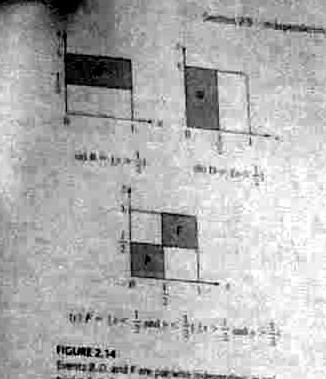Engineering Probability Class 6 Thurs 2019-01-31
Table of contents
1 Bayes theorem ctd
- Wikipedia on Bayes theorem. We'll do these examples in class.
- Example 2.28, page 51.
- Example 2.30, page 53, chip quality control: For example 2.28, how long do we have to burn in chips so that the survivors have a 99% probability of being good? p=0.1, a=1/20000.
2 Iclicker review of Bayes theorem
-
Event A is that a random person has a lycanthopy gene. Assume P(A) = .01.
Genes-R-Us has a DNA test for this. B is the event of a positive test. There are false positives and false negatives each w.p. (with probability) 0.1. That is, P(B|A') = P(B' | A) = 0.1
What's P(A')?
- 0.09
- .099
- .189
- .48
- .99
-
What's P(A and B)?
- 0.09
- .099
- .189
- .48
- .99
-
What's P(A' and B)?
- 0.09
- .099
- .189
- .48
- .99
-
What's P(B)?
- 0.09
- .099
- .189
- .48
- .99
-
You test positive. What's the probability you're really positive, P(A|B)?
- 0.09
- .099
- .189
- .48
- .99
3 Chapter 2 ctd: Independent eventa
-
2.5 Independent events
- \(P[A\cap B] = P[A] P[B]\)
- P[A|B] = P[A], P[B|A] = P[B]
-
A,B independent means that knowing A doesn't help you with B.
-
Mutually exclusive events w.p.>0 must be dependent.
-
Example 2.33, page 56.

-
More that 2 events:
- N events are independent iff the occurrence of no combo of the events affects another event.
- Each pair is independent.
- Also need \(P[A\cap B\cap C] = P[A] P[B] P[C]\)
- This is not intuitive A, B, and C might be pairwise independent, but, as a group of 3, are dependent.
- See example 2.32, page 55. A: x>1/2. B: y>1/2. C: x>y
-
Common application: independence of experiments in a sequence.
-
Example 2.34: coin tosses are assumed to be independent of each other.
P[HHT] = P[1st coin is H] P[2nd is H] P[3rd is T].
-
Example 2.35, page 58. System reliability
- Controller and 3 peripherals.
- System is up iff controller and at least 2 peripherals are up.
- Add a 2nd controller.
-
2.6 p59 Sequential experiments: maybe independent
-
2.6.1 Sequences of independent experiments
- Example 2.36
-
2.6.2 Binomial probability
- Bernoulli trial flip a possibly unfair coin once. p is probability of head.
- (Bernoulli did stats, econ, physics, ... in 18th century.)
-
Example 2.37
- P[TTH] = \((1-p)^2 p\)
- P[1 head] = \(3 (1-p)^2 p\)
-
Probability of exactly k successes = \(p_n(k) = {n \choose k} p^k (1-p)^{n-k}\)
-
\(\sum_{k=0}^n p_n(k) = 1\)
-
Example 2.38
-
Can avoid computing n! by computing \(p_n(k)\) recursively, or by using approximation. Also, in C++, using double instead of float helps. (Almost always you should use double instead of float. It's the same speed.)
-
Example 2.39
-
Example 2.40 Error correction coding
-
Multinomial probability law
-
There are M different possible outcomes from an experiment, e.g., faces of a die showing.
-
Probability of particular outcome: \(p_i\)
-
Now run the experiment n times.
-
Probability that i-th outcome occurred \(k_i\) times, \(\sum_{i=1}^M k_i = n\)
\begin{equation*} P[(k_1,k_2,...,k_M)]` :math:`= \frac{n!}{k_1! k_2! ... k_M!} p_1^{k_1} p_2^{k_2}...p_M^{k_M} \end{equation*}
-
-
Example 2.41 dartboard.
-
Example 2.42 random phone numbers.
-
2.7 Computer generation of random numbers
- Skip this section, except for following points.
- Executive summary: it's surprisingly hard to generate good random numbers. Commercial SW has been known to get this wrong. By now, they've gotten it right (I hope), so just call a subroutine.
- Arizona lottery got it wrong in 1998.
- Even random electronic noise is hard to use properly. The best selling 1955 book A Million Random Digits with 100,000 Normal Deviates had trouble generating random numbers this way. Asymmetries crept into their circuits perhaps because of component drift. For a laugh, read the reviews.
- Pseudo-random number generator: The subroutine returns numbers according to some algorithm (e.g., it doesn't use cosmic rays), but for your purposes, they're random.
- Computer random number routines usually return the same sequence of number each time you run your program, so you can reproduce your results.
- You can override this by seeding the generator with a genuine random number from linux /dev/random.
-
2.8 and 2.9 p70 Fine points: Skip.
-
Review Bayes theorem, since it is important. Here is a fictitious (because none of these probilities have any justification) SETI example.
- A priori probability of extraterrestrial life = P[L] = \(10^{-8}\).
- For ease of typing, let L' be the complement of L.
- Run a SETI experiment. R (for Radio) is the event that it has a positive result.
- P[R|L] = \(10^{-5}\), P[R|L'] = \(10^{-10}\).
- What is P[L|R] ?
-
Some specific probability laws
- In all of these, successive events are independent of each other.
- A Bernoulli trial is one toss of a coin where p is probability of head.
- We saw binomial and multinomial probilities in class 4.
- The binomial law gives the probability of exactly k heads in n tosses of an unfair coin.
- The multinomial law gives the probability of exactly ki occurrances of the i-th face in n tosses of a die.
-
iClicker: You have a coin where the probability of a head is p=2/3 If you toss it twice, what's the probability that you will see one head and one tail?
- 1/2
- 1/3
- 2/9
- 5/9
- 4/9